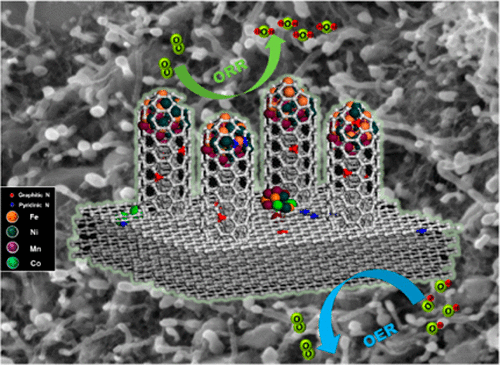当前位置:
X-MOL 学术
›
ACS Catal.
›
论文详情
Our official English website, www.x-mol.net, welcomes your feedback! (Note: you will need to create a separate account there.)
Quaternary FeCoNiMn-Based Nanocarbon Electrocatalysts for Bifunctional Oxygen Reduction and Evolution: Promotional Role of Mn Doping in Stabilizing Carbon
ACS Catalysis ( IF 12.9 ) Pub Date : 2017-11-08 00:00:00 , DOI: 10.1021/acscatal.7b02949 Shiva Gupta 1 , Shuai Zhao 2 , Xiao Xia Wang 1 , Sooyeon Hwang 3 , Stavros Karakalos 4 , Surya V. Devaguptapu 1 , Shreya Mukherjee 1 , Dong Su 3 , Hui Xu 2 , Gang Wu 1
ACS Catalysis ( IF 12.9 ) Pub Date : 2017-11-08 00:00:00 , DOI: 10.1021/acscatal.7b02949 Shiva Gupta 1 , Shuai Zhao 2 , Xiao Xia Wang 1 , Sooyeon Hwang 3 , Stavros Karakalos 4 , Surya V. Devaguptapu 1 , Shreya Mukherjee 1 , Dong Su 3 , Hui Xu 2 , Gang Wu 1
Affiliation

|
The intrinsic instability of carbon largely limits its use for the oxygen reduction reaction (ORR) and oxygen evolution reaction (OER) as a bifunctional catalyst in reversible fuel cells or water electrolyzers. Herein, we discovered that Mn doping has a promotional role in stabilizing nanocarbon catalysts for the ORR/OER in alkaline media. Stable nanocarbon composites are derived from an inexpensive carbon/nitrogen precursor (i.e., dicyandiamide) and quaternary FeCoNiMn alloy via a template-free carbonization process. In addition to FeCoNiMn metal alloys/oxides, the carbon composites comprise substantial carbon tube forests growing on a thick and dense graphitic substrate. The dense carbon substrate with high degree of graphitization results from Mn doping, while active nitrogen-doped carbon tubes stem from FeCoNi. Catalyst structures and performance are greatly dependent on the doping content of Mn. Various accelerated stress tests (AST) and life tests verify the encouraging ORR/OER stability of the nanocarbon composite catalyst with optimal Mn doping. Extensive characterization before and after ASTs elucidates the mechanism of stability enhancement resulting from Mn doping, which is attributed to (i) hybrid carbon nanostructures with enhanced resistance to oxidation and (ii) the in situ formation of the β-MnO2 and FeCoNi-based oxides capable of preventing carbon corrosion and promoting activity. Note that the improvement in stability due to Mn doping is accompanied by a slight activity loss due to a decrease in surface area. This work provides a strategy to stabilize carbon catalysts by appropriately integrating transition metals and engineering carbon structures.
中文翻译:

基于季铵盐的FeCoNiMn纳米碳电催化剂,用于双功能氧的还原和释放:Mn掺杂在稳定碳中的促进作用
碳的固有不稳定性极大地限制了其在可逆燃料电池或水电解槽中作为双功能催化剂用于氧还原反应(ORR)和氧释放反应(OER)的用途。在本文中,我们发现锰掺杂在稳定碱性介质中ORR / OER的纳米碳催化剂方面具有促进作用。稳定的纳米碳复合材料是通过一种无模板的碳化工艺从廉价的碳/氮前驱物(即双氰胺)和季铁钴镍锰合金中衍生而来的。除FeCoNiMn金属合金/氧化物外,碳复合材料还包括在厚而致密的石墨基底上生长的大量碳管林。Mn掺杂导致石墨化程度高的致密碳衬底,而活性氮掺杂碳管则来自FeCoNi。催化剂的结构和性能在很大程度上取决于Mn的掺杂量。各种加速应力测试(AST)和寿命测试验证了最佳Mn掺杂的纳米碳复合催化剂令人鼓舞的ORR / OER稳定性。AST前后的广泛表征阐明了Mn掺杂导致稳定性增强的机制,这归因于(i)具有增强的抗氧化性的杂化碳纳米结构,以及(ii)β-MnO的原位形成2和能够防止碳腐蚀并提高活性的FeCoNi基氧化物。注意,由于Mn掺杂而导致的稳定性的提高伴随有由于表面积减小而导致的轻微的活性损失。这项工作提供了通过适当整合过渡金属和工程碳结构来稳定碳催化剂的策略。
更新日期:2017-11-09
中文翻译:

基于季铵盐的FeCoNiMn纳米碳电催化剂,用于双功能氧的还原和释放:Mn掺杂在稳定碳中的促进作用
碳的固有不稳定性极大地限制了其在可逆燃料电池或水电解槽中作为双功能催化剂用于氧还原反应(ORR)和氧释放反应(OER)的用途。在本文中,我们发现锰掺杂在稳定碱性介质中ORR / OER的纳米碳催化剂方面具有促进作用。稳定的纳米碳复合材料是通过一种无模板的碳化工艺从廉价的碳/氮前驱物(即双氰胺)和季铁钴镍锰合金中衍生而来的。除FeCoNiMn金属合金/氧化物外,碳复合材料还包括在厚而致密的石墨基底上生长的大量碳管林。Mn掺杂导致石墨化程度高的致密碳衬底,而活性氮掺杂碳管则来自FeCoNi。催化剂的结构和性能在很大程度上取决于Mn的掺杂量。各种加速应力测试(AST)和寿命测试验证了最佳Mn掺杂的纳米碳复合催化剂令人鼓舞的ORR / OER稳定性。AST前后的广泛表征阐明了Mn掺杂导致稳定性增强的机制,这归因于(i)具有增强的抗氧化性的杂化碳纳米结构,以及(ii)β-MnO的原位形成2和能够防止碳腐蚀并提高活性的FeCoNi基氧化物。注意,由于Mn掺杂而导致的稳定性的提高伴随有由于表面积减小而导致的轻微的活性损失。这项工作提供了通过适当整合过渡金属和工程碳结构来稳定碳催化剂的策略。



























 京公网安备 11010802027423号
京公网安备 11010802027423号